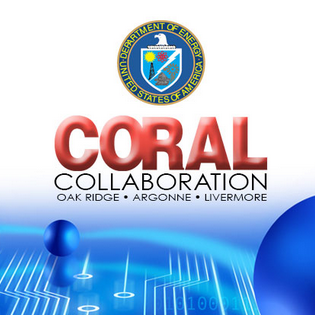A supercomputer named Aurora is on track to become the fastest system in the United States and possibly the world. Just a few hours ago, DOE Undersecretary Franklin “Lynn” Orr, announced that Intel Corp. and Cray Inc. had been selected to supply Argonne National Laboratory with a 180 petaflops system, Aurora, and a secondary system of about 8 petaflops, called Theta, marking the final installment in the Collaboration of Oak Ridge, Argonne, and Lawrence Livermore (CORAL) initiative.
“Aurora is expected to be 18x more powerful than Argonne’s current Mira system, but it will only use 2.7 times as much energy,” said Undersecretary Orr, speaking from the offices of innovative startup space, 1871 Chicago, not far from Argonne National Lab where the new systems will be located. This kind of energy efficiency is crucial for deploying the coming generation of exascale-class supercomputers, he continued.
Aurora is scheduled to come online in 2018, as an Office of Science budget document that was released earlier this year showed. Theta will arrive in 2016 to support Argonne with the transition from Mira to Aurora. As prime contractor for contract, Intel Federal, a wholly-owned subsidiary of Intel Corp., is responsible for the delivery of the two systems, a position that Intel last held nearly two decades ago with the installment of ASCI Red at the Sandia National Laboratory.
Undersecretary Orr and many of the other speakers at the event, which included Argonne National Laboratory Director, Peter Littlewood, and several prominent Illinois Congressmen, emphasized the importance of this pre-exascale system for maintaining US global leadership in computing. The machine is on track to enable research goals in areas spanning biological science, material sciences, transportation efficiency, renewable energy, and many more applications that require leadership-class high-performance computing.
It should come as no surprise that Aurora, which is in the running to be the world’s preeminent supercomputer when it comes online, involves a number of new technologies. It will be the first system built on Cray’s “Shasta” architecture, which is a follow on to its current XC series. As described by Cray’s Barry Bolding, Shasta is a combination of new Intel technologies and Cray’s adaptive supercomputing vision. The interim system, Theta, will be based on the Cray XC supercomputer, powered by Intel Xeon processors and “Knights Landing” Phi coprocessors.
“A productive supercomputer has to be able to solve problems both at scale but also to use best-of-breed technologies both from a computing standpoint, interconnect and software standpoint,” noted Bolding at the press event. “We look at systems as holistic, integrated, productive devices that scientists can use, and put to good use, and Shasta, the system architecture that will be the component for this Aurora system, is really a giant step for Cray, a giant step in our collaborations with Intel, and it’s a giant step in our collaboration with the Department of Energy.”
Dave Patterson, president of Intel’s federal unit, characterized the Aurora system as representing a unique architectural direction based on Intel’s HPC scalable system framework. The new framework provides “a flexible blueprint for developing high-performance, balanced, power-efficient and reliable systems capable of supporting both compute- and data-intensive workloads,” said Patterson. “The framework combines Intel’s next-generation Xeon and Xeon Phi processors, OmniPath fabric, Silicon Photonics, innovative memory technologies, and a high-performance software stack along with the ability to efficiently integrate them into a broad spectrum of system solutions.”
The announcement represents the final piece of the CORAL program, the joint procurement effort to secure next-generation supercomputers for Department of Energy’s National Laboratories at Oak Ridge, Argonne, and Livermore that launched in 2014. Details of the first two systems, Summit and Sierra, were revealed last year as part of a $325 million project. Today’s announcement boosts the total CORAL investment to $525 million.
Aside from the major system announcements, the Office of Science and the National Nuclear Security Administration are making longer-term investments in exascale computing under the DesignForward R&D program. Today $10 million in contracts were awarded to AMD, Cray, IBM and Intel, complementing the $25.4 million that was invested in the first round of DesignForward. Another $100 million in pro-exascale development funding was announced in December 2014 as part of FastForward 2, a joint research and development program between government labs and vendor partners Cray, Intel, NVIDIA and AMD.
One requirement of CORAL was that Oak Ridge National Lab and Argonne National Lab would have architecturally diverse computers to manage risk during a period of rapid technological evolution. As the previously announced CORAL systems, Sierra and Summit, will be based on technology being developed by IBM, NVIDIA and Mellanox, it was expected that Argonne would go a different direction with a Cray-Intel system the likeliest choice.
While Cray took the opportunity to introduce its next-generation Shasta architecture, we still don’t know a lot about the Intel chips that will be part of Aurora. Given the 2018 timeframe, there is a good chance that the Phi processors used in the system will be the third-generation Many Integrated Core (MIC) parts, codenamed Knights Hill. Intel disclosed the name of this future line at SC14, but little else is known, other than they will be on the 10 nanometer process, which offers more density, power and performance. Intel has also said that Knights Hill will carry forward the programming story of high-level compatibility with standards and with Intel architecture.





























































